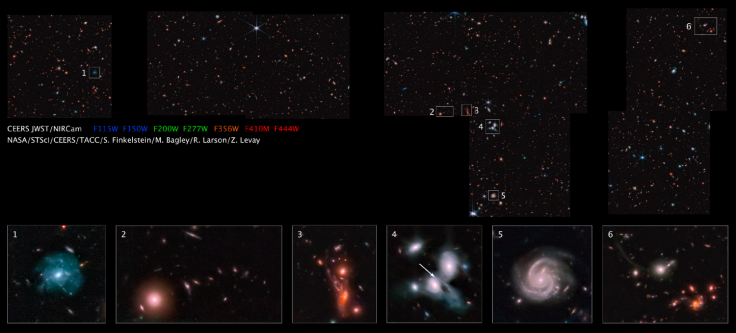The James Webb Space Telescope has given the world another HD glimpse of space.
Scientists from the Cosmic Evolution Early Release Science Survey (CEERS) have released a mosaic of images from NASA's James Webb Space Telescope (JWST or simply Webb) using pictures taken by its Near Infrared Camera (NIRCam).
The images captured numerous galaxies and even a supernova, per Space.com.
CEERS Epoch 1 Mosaic Details

CEERS scientists mentioned in a statement that Webb had taken its first epoch of observations for its survey, resulting in a picture that became the largest picture the telescope took to date.
The picture covers near-infrared to mid-infrared wavelengths in the EGS field, which is a small patch of sky near the handle of the Big Dipper constellation.
The Epoch 1 image, the name of which the picture is now known, shows distant galaxies whose light has shifted from visible to infrared during their journey through time and space. However, the galaxies captured in the image presented curiosities that are inspiring scientists further study them.
Additionally, Epoch 1 also captured never-before-seen galaxies in abundance, which led to new discoveries, per CEERS' statement.
these new galaxies include a highly-redshifted object, which was recently named "Maisie's galaxy."
The galaxy, which was named after the daughter of project head Steven Finkelstein may be one of the earliest galaxies ever observed; calculations from experts place the galaxy existing less than 400 million years after the Big Bang.
In addition to Maisie's galaxy, the Epoch 1 image also captured smaller galaxies forming an arc near a bright one, interacting spiral galaxies, red galaxies, and even a supernova.
A supernova is a powerful and bright explosion of a star that had reached the end of its life, per NASA. It happens when a massive star runs out of fuel to burn, which causes the star's internal pressure to drop. This pressure collapse results in shock waves powerful enough to cause the star's outer part to explode.
Is There More To Come?
Please go download the high-resolution versions of these images. I hope you are just as awe-inspired and excited about this telescope and the data as I have been. I am so lucky to share them with you & hope you find your new favorite galaxies in them too! https://t.co/DJcBu8DMFl
— Dr. Rebecca Larson (@SaturnsWings) August 16, 2022
Astrophysicist, CEERS team member, and National Science Foundation fellow Rebecca Larson mentioned in her official Twitter account that the collaboration between CEERS and Webb is still less than halfway through its full survey.
The survey Larson mentioned is designed to test if Webb is capable of making extragalactic surveys while it is conducting other observations, meaning that CEERS will be releasing more pictures similar to the Epoch 1 image in the foreseeable future.
"I hope you are just as awe-inspired and excited about [Webb] and the data as I have been," Larson said on her Twitter page. "I am so lucky to share them with you & hope you find your new favorite galaxies in them too!"
It is unknown when the next Epoch image will be released to the public.
People interested in seeing the Epoch 1 image for themvelves can visit the official CEERS website.
Related Article: NASA Releases New James Webb Space Telescope Photos of Jupiter









